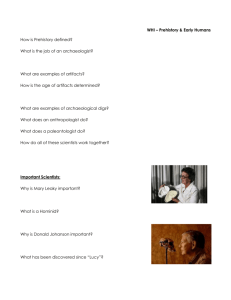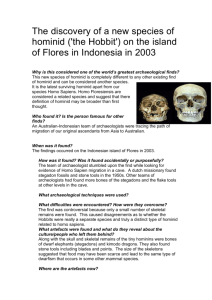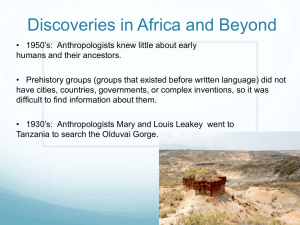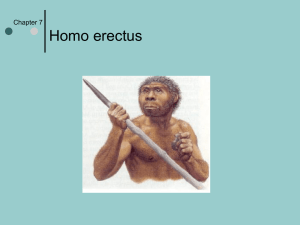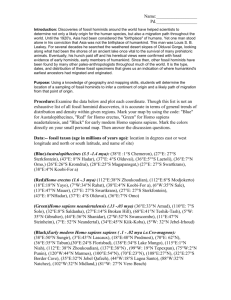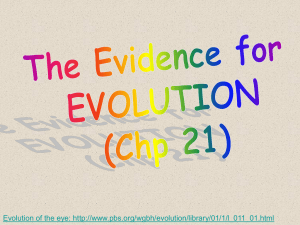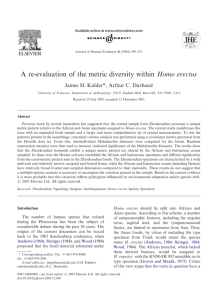NGANDONG MENSEN The Ngandong hominin skulls are eleven
advertisement
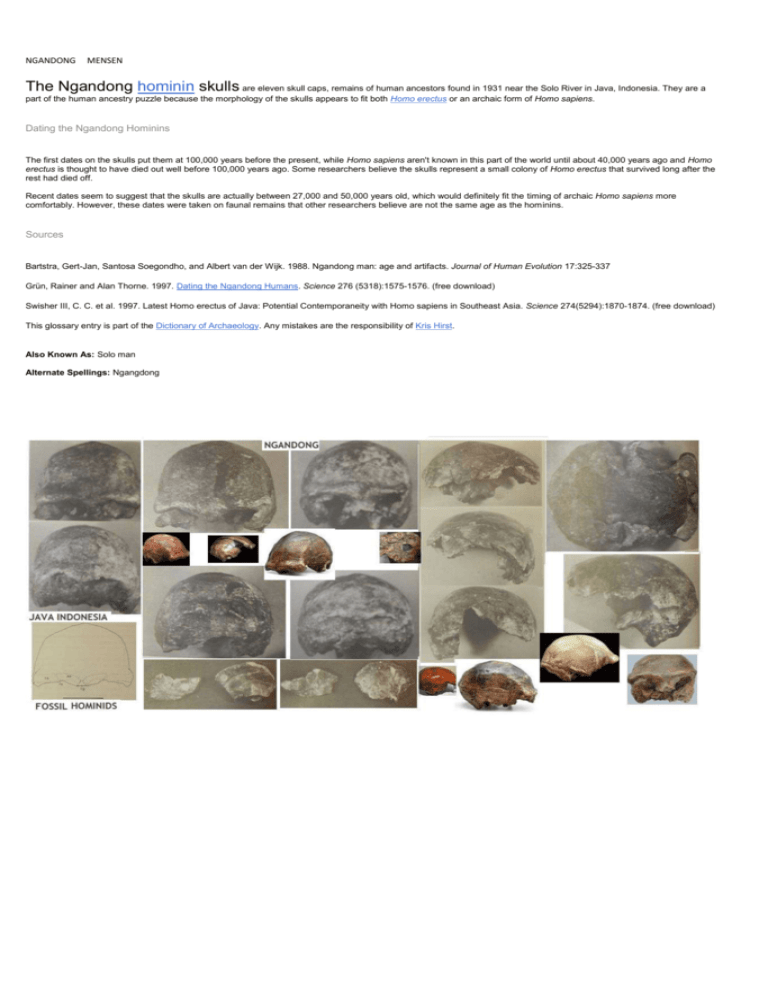
NGANDONG MENSEN The Ngandong hominin skulls are eleven skull caps, remains of human ancestors found in 1931 near the Solo River in Java, Indonesia. They are a part of the human ancestry puzzle because the morphology of the skulls appears to fit both Homo erectus or an archaic form of Homo sapiens. Dating the Ngandong Hominins The first dates on the skulls put them at 100,000 years before the present, while Homo sapiens aren't known in this part of the world until about 40,000 years ago and Homo erectus is thought to have died out well before 100,000 years ago. Some researchers believe the skulls represent a small colony of Homo erectus that survived long after the rest had died off. Recent dates seem to suggest that the skulls are actually between 27,000 and 50,000 years old, which would definitely fit the timing of archaic Homo sapiens more comfortably. However, these dates were taken on faunal remains that other researchers believe are not the same age as the hominins. Sources Bartstra, Gert-Jan, Santosa Soegondho, and Albert van der Wijk. 1988. Ngandong man: age and artifacts. Journal of Human Evolution 17:325-337 Grün, Rainer and Alan Thorne. 1997. Dating the Ngandong Humans. Science 276 (5318):1575-1576. (free download) Swisher III, C. C. et al. 1997. Latest Homo erectus of Java: Potential Contemporaneity with Homo sapiens in Southeast Asia. Science 274(5294):1870-1874. (free download) This glossary entry is part of the Dictionary of Archaeology. Any mistakes are the responsibility of Kris Hirst. Also Known As: Solo man Alternate Spellings: Ngangdong BU362507.jpg http://www.weekbladbuiten.net/OZfoto2Dasplist.asp?x_Plaats=Ngandong&z_Plaats=LIKE%2C'%25%2C%25' Ngandong Indonesië 1936 De schedel van Ngandong van terzijde gezien. Men lette op de torus supra-orbitalis (wenkbbrauwboog-rechel) (Naar Oppenoorth) http://www.weekbladbuiten.net/OZfoto2Dasplist.asp?x_Plaats=Ngandong&z_Plaats=LIKE%2C'%25%2C%25' Nederlands indie 2 / 11 Indonesië BU362508.jpg http://www.weekbladbuiten.net/OZfoto2Dasplist.asp?x_Plaats=Ngandong&z_Plaats=LIKE%2C'%25%2C%25' Ngandong 1936 3 / 11 BU362509.jpg http://www.weekbladbuiten.net/OZfoto2Dasplist.asp?x_Plaats=Ngandong&z_Plaats=LIKE%2C'%25%2C%25' Ngandong Indonesië 1936 Schedeldak van den Ngandongmensch van boven bezien. Let op de postorbitale insnoering (insn. Boven achter de oogholten) (N. Oppenoorth) 5 / 11 Ngandong http://genome.cshlp.org/content/8/4/339.full Fossil modern hominid skulls from Australia and Africa, compared with the H. erectus Ngangdong skull from Java. (A) Cast of Ngangdong, ( (A) R. Foley; (http://www.une.edu.au/~Arch/PalaeoIndes.html/. Homo Erectus More on Ngandong Hominins Ngandong (Genome research) Ngangong (Rainer & Thorne) Ngangdong Fossil Hominids (A.P. Santa Luca) Related Articles Homo Erectus Colonization in Europe - Pakefield Homo erectus in England Further Fossil Finds of Flores Man, Indonesia: Nine More of the Hobbit'... Peking Man - Homo erectus specimen called Peking Man What is a Caucasoid - Kennewick Man Part 2 - What is a Caucasoid Weird Skeletons in Mankind's Closet Related Glossary Entries Homo Hominid Hominin More on Human Origins Human Origins http://archaeology.about.com/library/glossary/bldef_homo.htm AUSTRALIE / ARCHAIC HOMO AFRICA MUNGO MENS 6 / 11 Lake Mungo 3 http://genome.cshlp.org/content/8/4/339.full Fossil modern hominid skulls from Australia and Africa, compared with the H. erectus Ngangdong skull from Java. Photograph credits: (A) R. Foley; (B–E) kindly supplied by Peter Brown (University of New England, Armidale, NSW, Australia); (F,G) kindly supplied by Chris Stringer (Natural History Museum, London, UK). For further information about the fossil Australian hominids, see Peter Brown’s Web page at http://www.une.edu.au/~Arch/PalaeoIndes.html/. http://www.convictcreations.com/aborigines/prehistory.htm Willandra Lakes 50 (WLH-50, Fossil modern hominid skulls from Australia and Africa, compared with the H. erectus Ngangdong skull from Java. Photograph credits: (B–E) kindly supplied by Peter Brown (University of New England, Armidale, NSW, Australia); http://www.une.edu.au/~Arch/PalaeoIndes.html/. http://genome.cshlp.org/content/8/4/339.full 8 / 11 Kow Swamp Fossil modern hominid skulls from Australia and Africa, compared with the H. erectus Ngangdong skull from Java. (A) Cast of Ngangdong, (B) Lake Mungo 3 (Australia); (C) Willandra Lakes 50 (WLH-50, Australia); (D) Kow Swamp (Australia): (E) Keilor (Australia); (F) Ngaloba (African transitional); (G) Omo Kibish (early modern African). Photograph credits: (A) R. Foley; (B–E) kindly supplied by Peter Brown (University of New England, Armidale, NSW, Australia); (F,G) kindly supplied by Chris Stringer (Natural History Museum, London, UK). For further information about the fossil Australian hominids, see Peter Brown’s Web page at http://www.une.edu.au/~Arch/PalaeoIndes.html/. http://genome.cshlp.org/content/8/4/339.full 9 / 11 Keilor Fossil modern hominid skulls from Australia and Africa, compared with the H. erectus Ngangdong skull from Java.(B–E) kindly supplied by Peter Brown (University of New England, Armidale, NSW, Australia); http://www.une.edu.au/~Arch/PalaeoIndes.html/. http://genome.cshlp.org/content/8/4/339.full 10 / 11 Ngaloba (African transitional); Fossil modern hominid skulls from Australia and Africa, compared with the H. erectus Ngangdong skull from Java. Ngaloba (African transitional); (F,G) kindly supplied by Chris Stringer (Natural History Museum, London, UK). For further information about the fossil Australian hominids, see Peter Brown’s Web page at http://www.une.edu.au/~Arch/PalaeoIndes.html/. http://genome.cshlp.org/content/8/4/339.full 11 / 11 (G) Omo Kibish (early modern African). Fossil modern hominid skulls from Australia and Africa, compared with the H. erectus Ngangdong skull from Java. Omo Kibish (early modern African). Photograph credits: (A) R. Foley; (F,G) kindly supplied by Chris Stringer (Natural History Museum, London, UK). For further information about the fossil Australian hominids, see Peter Brown’s Web page at http://www.une.edu.au/~Arch/PalaeoIndes.html/. http://genome.cshlp.org/content/8/4/339.full

